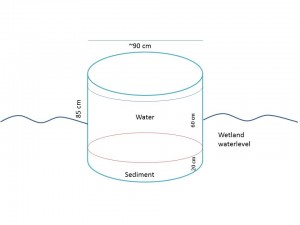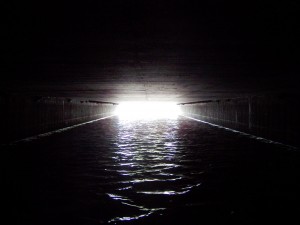I’m building mesocosms. It’s tricky, there are no directions, and I’m not really sure what the finished product should look like. But my degree depends on it. I have four months to figure out this problem. This is what I envisioned:
This is what I built:
But it leaks, not because I built it wrong but because the sediment is both too hard and too soft. It’s too hard to push the plastic deeply into it and too soft to create a water tight seal if I try to manipulate the water level. I may not be able to manipulate the water level. It doesn’t ruin the project, but I have to pay attention. This needs to work or I need to make it work.
It has been nice to visit the wetland a few times this week. The flows are high, the water is clean. The reeds are pretty small right now so there is good visibility. I love walking around the apparently abandoned beaver dams and seeing the complex engineering they built. Clever beavers.
I’ve been working in Hobble Creek for two years now. Donating blood and sweat in the name of science as I collected invertebrates and measure temperature, depth, flow, vegetation, oxygen and so forth. I’ve seen dozens of species come through. I’ve seen it frozen, flooded, drying out, under construction, burned by a blazing sun and soaked by a rainy sky. I’ve seen it at all hours of the day and night. These few acres are my laboratory and my church in many ways, although the nearby campus serves more formally in both roles.
All this work has been possible because some pioneers overfished a once abundant large fish from this area. After allowing this fish to save them when crickets destroyed their crops (sure the seagulls helped kill the pests but where did the food come from until the crops could grow?) the pioneers introduced carp for some reason. The June Sucker became endangered and millions of dollars were sent to save it. For two years those monies have paid for my research and dozens of trips to this small wetland in the shadow of a freeway. All to save a fish that I have never seen outside of a fish tank or a bucket of alcohol.
Today I was out there and decided to explore the new culvert under the freeway. As I entered the dark cave with water up to my knees hundreds of swallows nesting under the bridge attacked me like bats. Okay, attacked is strong. They flew out in force leaving droppings to pling on the water as they took off. I fixed my eyes on the bright light on the other end of the tunnel and walked through the mucky water. I could barely hear the thunder of freeway traffic over my head. I could see the salt forming crystalline formations as it seeped through the cracks in the concrete. Cold, dark, and wet. What place could be less pleasant? Oh, I was alone.
I reached the east side of the freeway and was astonished to see substrate again. Then I saw it.
A June Sucker.
14 inches or so, a dark top and white underbelly just as I had been taught in 14 weeks of ichthyology class. I could see its sucking mouth slightly pointed upwards rather than at the bottom like most suckers. It “sat” there, face upriver, sucking in water to catch little bits of invertebrate or organic matter. I stepped closer. Instead of fleeing it slowly swam over to me as I grabbed for the camera. It moved behind me, hiding in my wake and lightly brushing its lips against my boots. It moved on, slowly gliding through the water and out of sight.
A biologist gets excited about such things. They measure and record and bask, understanding that no one else can understand what it means to have seen an endangered species swimming up river during spawning season.
A writer tries to make everyone else understand. June Suckers are endangered because the spawning runs have failed. The fish should swim up river from Utah Lake every spring when runoff is high to lay eggs. The baby fish then float into riparian ponds or shallow margins of the lake to grow up before heading into the lake. Out in the lake they are easy food for larger fish. But dams have stopped the spring runoff. Invasive reeds clog the river deltas, and the carp eat the baby June Suckers. My research was funded to prove that Hobble Creek is a good place, in its restored state, for these fish to breed.
Today, for the first time, I saw a real live fish swimming upriver probably to spawn; a fish that came up and fearlessly kissed my feet before moving on.
I’ll find a way to get the mesocosms to work. Things can get better. It’s true that not every effort produces results. But it is also true that some do and those are worth the cost of the ones that don’t.





..and the earth is being renewed!
I loved this story. Hooray!
Way to go Riley! You need plastic that screws into the dirt… Alternatively, find a handy civil engineer. Or construction dude. They deal with water and getting stuff down into the ground all the time. Or at least they do on my projects. Congrats on getting your feet kissed by a fish!